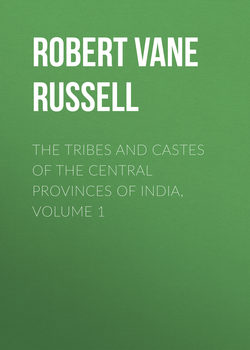Читать книгу The Tribes and Castes of the Central Provinces of India, Volume 1 - Robert Vane Russell - Страница 46
Part I.
Introductory Essay on Caste
Introductory Essay on Caste
43. Other agents in the formation of castes
ОглавлениеThe great majority of castes have been formed from occupation, but other sources of origin can be traced. Several castes are of mixed descent, as the Vidūrs, the descendants of Brāhman fathers and mothers of other castes; the Bhilālas, by Rajpūt fathers and Bhīl mothers; the Chauhāns, Audhelias, Khangārs and Dhākars of Bastar, probably by Hindu fathers and women of various indigenous tribes; the Kirārs of mixed Rajpūt descent, and others. These also now generally take rank according to their occupation and position in the world. The Vidūrs served as village accountants and ranked below the cultivators, but since they are well educated and have done well in Government service their status is rapidly improving. The Bhilālas are landholders and rank as a good cultivating caste. The Chauhāns and Khangārs are village watchmen and rank as menials below the cultivators, the Dhākars are farmservants and labourers with a similar position, while the Audhelias are labourers who keep pigs and are hence regarded as impure. The Halbas or ‘ploughmen’ are another mixed caste, probably the descendants of house-servants of the Uriya Rājas, who, like the Khandaits, formed a sort of militia for the maintenance of the chiefs authority. They are now mainly farmservants, as the name denotes, but where they hold land, as in Bastar, they rank higher, almost as a good cultivating caste.
Again, very occasionally a caste may be formed from a religious sect or order. The Bishnois were originally a Vaishnava sect, worshipping Vishnu as an unseen god, and refusing to employ Brāhmans. They have now become cultivators, and though they retain their sectarian beliefs, and have no Brāhman priests, are generally regarded as a Hindu cultivating caste. The Pankas are members of the impure Gānda caste who adhered to the Kabīrpanthi sect. They are now a separate caste and are usually employed as village watchmen, ranking with menials above the Gāndas and other similar castes. The Lingāyats are a large sect of southern India, devoted to the worship of Siva and called after the lingam or phallic emblem which they wear. They have their own priests, denying the authority of Brāhmans, but the tendency now is for members of those castes which have become Lingāyats to marry among themselves and retain their relative social status, thus forming a sort of inner microcosm of Hinduism.
